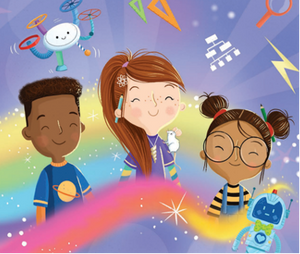Children today are growing up in an ever-changing digital world. The Fourth Industrial Revolution is on our doorstep – and the aim of QuestFriendz as a publisher is to equip children with new and different skillsets.
Developing STEM skills, including computational and critical thinking, and gaining a certain level of confidence in these areas, is critical from a young age. Research shows that exposure to and building confidence in these disciplines, can often be a predictor to following a career in STEM fields.
Learning to learn has become more important than ever, to help children to:
- adapt and learn
- learn how to break down bigger problems into smaller ones
- develop their curiosity and critical thinking skills
- use logical thinking to predict outcomes - what makes sense and how to reach a logical conclusion.
The good news is, that inspiring children’s interest in STEM activities from a young age is possible with imaginative and active hands-on play. Young children’s natural curiosity is a magical state of mind that supercharges learning. Introducing problem-solving skills and learning to fail from a young age, children are better equipped to face a fast-paced, changing world and provides a memorable experience to harness children’s natural curiosity.
The key is to connect children’s imagination and curiosity to the world they live in with simple challenges (we call them quests), where problem-solving, critical thinking, collaboration and creativity are the keys to finding solutions.
Here are three simple and practical STEM ideas that will engage and develop transferable critical and computational thinking skills for children aged 4-8 (covering some of the essential KS1 objectives for the computing national curriculum).
Tip: Lego is a great learning tool!
Flying high
- Aim: To give children a mission as avionics engineers to design and create a plane that glides the farthest.
- You will need: any materials that can be found around the classroom or at home.
- Task: children are asked to create designs for several different planes or gliders. Using diverse material (e.g. paper of diverse weights and textures, carton, foil, parchment paper, etc.), these should then be made into different prototypes. Test all planes as part of a mini competition – distances to be measured and recorded by an ‘official’ panel. The winner is the plane that has flown the furthest. Bonus points can be awarded for creativity and design.
- Outcomes: This quest focuses on predicting behaviour via experimentation and developing a continuous improvement mindset via testing and improving their plane design over and over to get better results.
Building challenge
- Aim: Children to work in pairs or small teams to build a small house for their favourite small toy out of Lego or building blocks.
- You will need: Lego/building blocks and a small barrier/box/screen
- Task: The first child/team should build their structure behind the barrier/screen, without letting the other child/team see what they are doing. Once they have finished, the next challenge is to ask the child/team to give instructions to their classmate(s) or teacher, on how to build an identical house, piece by piece.
- Outcomes: Children learn to write a small a program with clear instructions. The description of how the blocks relate to each other in space will determine how quickly and successfully the second structure will be built, identical to the first. This is a great way for children to outline solutions and communicate clearly the steps needed to get there.
Engineer a bridge
- Aim: For children to take on the role of a civil engineer with the mission to design and build a bridge which can sustain the weight of a small toy. The bridge may have to be tested and rebuilt several times.
- You will need: Lego or any other materials you have around your house or classroom
- Outcomes: Trial and error approach is a fundamental method of problem-solving and debugging. Children will get to experience this first-hand and learn from it to improve an initial design iteratively until they find a satisfactory solution.
Parents and teachers can invent and create more quests to further encourage children and trigger their interest in STEM education.
The brand new SuperQuesters series provides fun quests and interactive learning to develop STEM skills in children aged 4-8. The first book: SuperQuesters: The Case of the Stolen Sun is out on May 3rd, 2022.
For more fun, educational STEM activity sheets and educational resources, visit www.QuestFriendz.com








